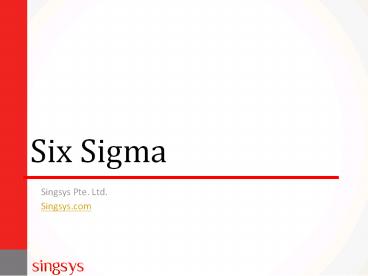Six Sigma: Practice Quality to Boost Business Output - PowerPoint PPT Presentation
Title:
Six Sigma: Practice Quality to Boost Business Output
Description:
Six Sigma is methodology through which you can reduce the error repetition which increase your productivity. Six sigma will help you to make your process smooth and error free. – PowerPoint PPT presentation
Number of Views:47
Title: Six Sigma: Practice Quality to Boost Business Output
1
Six Sigma
- Singsys Pte. Ltd.
- Singsys.com
2
Six Sigma
- Six Sigma is a technique with primary focus on
regular enhancement towards customer satisfaction
and profit. - It is supposed to identify the core causes of
error and eliminate it, as well as reduce the
possible variability that exists in manufacturing
and business processes. This will improve overall
output quality of a process. A bunch of quality
management methods generally empirical, and
statistical methods are used for the creation of
people infrastructure in an organization who
excel in these methods. - Upon Calculating the quantity of defect present
in the process it will help you in eliminating
these in a systematic manner and achieve zero
defects. This technically means a failure rate of
3.4 parts per million or 99.9997 perfect.
3
Features of Six Sigma
- Six Sigma boosts customer satisfaction by getting
rid of waste and inefficiency and eventually
delivers exactly what is expected by the
customer. - Six Sigma stick to a meticulously planned
methodology where exclusive roles are exclusive
designed for every participant. - Six Sigma is a data dependent approach that
requires appropriate data collection in order to
analyze various processes. - Six Sigma is regarding putting up results on
Financial Statements.
4
Features of Six Sigma
- Six Sigma is a business-oriented, multifaceted
structured approach for - Process Improvement
- Decreasing Defects
- Limiting Process Variability
- Cost Reduction
- Boosting Customer Satisfaction
- Skyrocket Profits
5
Key Concepts of Six Sigma
- Critical to Quality Attributes hold primary
importance to the customer.. - Defect Failure on delivering as per customer
expectation. - Process Capability What all your process can
deliver. - Variation What the customer sees and how he
feels. - Stable Operations Ensuring consistent,
predictable processes to improvise what the
customer sees and feels. - Design for Six Sigma Designing to fulfill
customer requirements and process capability. - Our Customers Feel the Variance, Not the Mean.
Hence, Six Sigma starts with reducing process
variation and then move towards improving the
process capability.
6
Key Elements Of Six Sigma
Customers Obviously customers define quality.
They expect performance, reliability, competitive
prices, on-time delivery, service, clear and
correct transaction processing and much more.
This reflects the importance of delivering
exactly in accordance to customer need to
maintain customer satisfaction. Processes The
quality of the process is supposed to be viewed
from customer's perspective. After identification
of transaction life-cycle from customer's point
of view, we can capture their requirements and
understand every detail of customer requirement.
This will help in identification of weak spots
inside the process so further improvement can be
done quickly. Employees It is imperative to Six
Sigma that every employee is handed over
structured job roles with measurable objectives.
7
Benefits of Six Sigma
- Parallel improvement in Customer Satisfaction,
Employee Motivation Satisfaction, Market Share
and Business Results - Step-change and non-stop improvement.
- Improved business processes
- Hearts and minds of all employees engaged
- Low value-adding activities removed
- Fragmented and piecemeal approaches prevented
- Fire-fighting eliminated
- Day-to-day operations simplified
8
Benefits of Six Sigma
- Cuts through the fog and noise of everyday
business - Easy to understand and implement - in whole or in
part - Frees up Management time to focus on those
activities that make a 'real difference'
9
Methodologies
- Six Sigma projects adhere to two project
methodologies inspired by Deming's Plan-Do-Check-
Act Cycle. These methodologies, made up of five
phases each, hold the acronyms DMAIC and DMADV. - DMAIC is used for projects focused on improving
an existing business process. - DMADV is used for projects focused on producing
new product or process designs.
10
DMAIC
- Define the problem in detail, the voice of the
customer, and the expected project goals to be
specific. - Measure key aspects of the existing process and
capture relevant data. - Analyse the data to analyze and validate the
cause-and-effect relationships. Define the crux
of relationships and undertake the responsibility
to ensure that all factors have been included.
Identify the root cause of the defect under
analysis. - Improve or optimise the existing process on
behalf of data analysis using techniques like
design of experiments, poka yoke or mistake
proofing, and standard work to create a new,
futuristic state process. Set up pilot runs to
establish and enhance process capability. - Control over future state process to ensure that
any deviations from target are rectified before
they display the defects. Control systems are
implemented which include statistical process
control, visual workplaces, and production boards
also the process is regularly monitored.
11
DMADV
- Define design goals that fulfill customer demands
and are consistent with enterprise strategy. - Measure and locate CTQs (characteristics that are
Critical To Quality), product capabilities,
production process capability, and risks. - Analyse deeply to develop and design
alternatives, create a high-level design and
evaluate design capacity to choose the best
design. - Design details, optimise the design, and plan for
design verification. This phase might need some
simulations. - Verify the design, set up pilot runs, excute the
production process and hand it over to the
process owner(s).
12
Six Sigma Startup
- Plan your own path There may be multiple paths
but the most appropriate path is the one which is
best for entire organization. - Declare your objective Decide what you want to
achieve and prioritize your work accordingly. - Focus on feasibility Setup your goals such that
they smartly match up your resources as well as
the scopes.
13
Thank You































